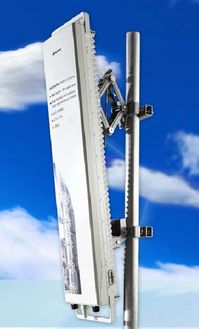Pentaband Antennas Deployed
Posted by on
Saudi Telecom will deploy Huawei Penta-band Antennas
to boost their TD-LTE and FD-LTE network. STC, the Middle East’s
largest operator with 160 million subscribers, decided to deploy Penta-band Antennas
since its GSM/UMTS network was unable to meet rapid growth in demands
for data services. It now operates the world’s largest TDD/FDD
convergent network.
 Huawei’s Penta-band antennas simultaneously supports five bands on the 690-960MHz and 4×1710-2690MHz spectrum bands in a single compact antenna design.
Huawei’s Penta-band antennas simultaneously supports five bands on the 690-960MHz and 4×1710-2690MHz spectrum bands in a single compact antenna design.
The antennas support plug-and-play EasyRET (Remote Electronic Tilt), which provides embedded remote control unit to enhance system efficiency. Different spectrum bands are able to be independently adjusted to achieve better coverage.
Huawei says they have shipped more than 1.65 million antennas to more than 360 operators in 155 countries. According to ABI Research, the Total Cost of Ownership is 13% lower for a LTE-TDD network. If utilized for backhaul, LTE-TDD can provide a 33% saving over Point-To-Point Microwave and a 43% saving over fiber.
Sprint recently demonstrated 2.6 Gbps TD-LTE throughput over a single sector using NSN’s commercially available Flexi Multiradio 10 Base Station. The tests conducted at NSN’s Mountain View facility, aggregated 120 MHz of Sprint’s TDD spectrum to achieve an unprecedented speed of 2.6 Gbps.
The previous record was 1.6 Gbps.
Sprint has plenty of 60 GHz chunks, which can deliver over 1.3 Gbps.
Even if the average total throughput is something closer to 300 Mbps to
end users, that’s still equivalent to 100 HD video streams (using H.265
at 3 Mbps each).
NSN’s TD-LTE 8-pipe radio module supports up to 120 MHz of channel bandwidth in Band 41 spectrum (used by Sprint’s 2.6 GHz band). The 2.6 GHz LTE TDD spectrum is used in Brazil, China, India, Japan, Russia and the USA.
Broadcom, NSN and Finnish operator Elisa demonstrated LTE data rates of 300 Mbps on a live commercial network in the Nordic Countries, aggregating two 20 MHz channels, one in the 1800 MHz band (LTE Band 3) and one in the 2600 MHz band (LTE Band 7) to reach speeds of 300 Mbps.
NSN provides infrastructure equipment for all three of South Korea’s FDD-based LTE Advanced networks, which were each launched last summer by SK Telecom, KT and LG U+.
 Huawei’s Penta-band antennas simultaneously supports five bands on the 690-960MHz and 4×1710-2690MHz spectrum bands in a single compact antenna design.
Huawei’s Penta-band antennas simultaneously supports five bands on the 690-960MHz and 4×1710-2690MHz spectrum bands in a single compact antenna design.The antennas support plug-and-play EasyRET (Remote Electronic Tilt), which provides embedded remote control unit to enhance system efficiency. Different spectrum bands are able to be independently adjusted to achieve better coverage.
Huawei says they have shipped more than 1.65 million antennas to more than 360 operators in 155 countries. According to ABI Research, the Total Cost of Ownership is 13% lower for a LTE-TDD network. If utilized for backhaul, LTE-TDD can provide a 33% saving over Point-To-Point Microwave and a 43% saving over fiber.
Sprint recently demonstrated 2.6 Gbps TD-LTE throughput over a single sector using NSN’s commercially available Flexi Multiradio 10 Base Station. The tests conducted at NSN’s Mountain View facility, aggregated 120 MHz of Sprint’s TDD spectrum to achieve an unprecedented speed of 2.6 Gbps.
NSN’s TD-LTE 8-pipe radio module supports up to 120 MHz of channel bandwidth in Band 41 spectrum (used by Sprint’s 2.6 GHz band). The 2.6 GHz LTE TDD spectrum is used in Brazil, China, India, Japan, Russia and the USA.
Broadcom, NSN and Finnish operator Elisa demonstrated LTE data rates of 300 Mbps on a live commercial network in the Nordic Countries, aggregating two 20 MHz channels, one in the 1800 MHz band (LTE Band 3) and one in the 2600 MHz band (LTE Band 7) to reach speeds of 300 Mbps.
NSN provides infrastructure equipment for all three of South Korea’s FDD-based LTE Advanced networks, which were each launched last summer by SK Telecom, KT and LG U+.




No comments:
Post a Comment